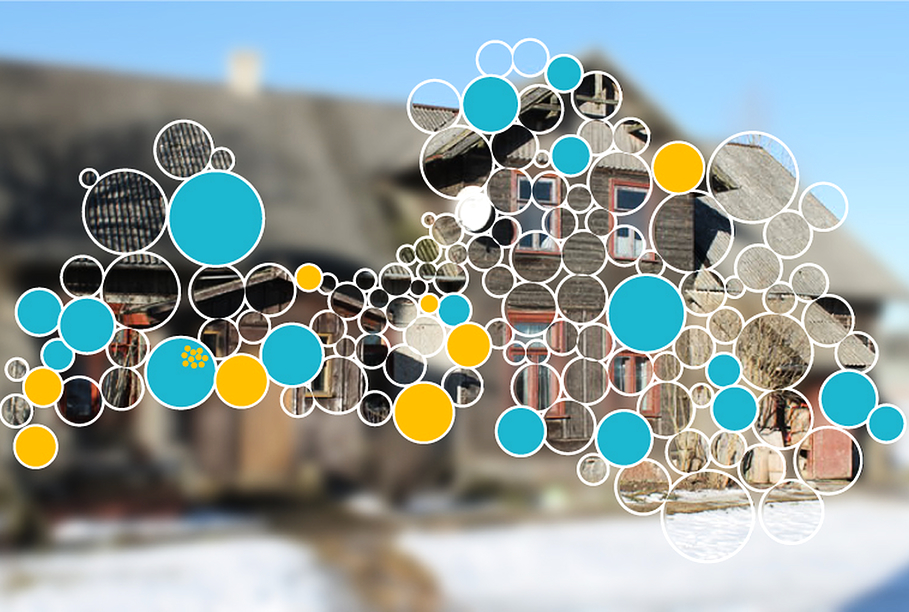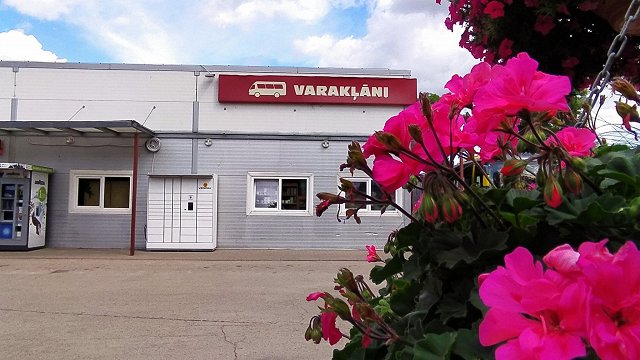Of the more than 6500 officially recognized villages throughout the land, according to the address registry the state Land Service can only depict barely a third.
The provinces of south-central Zemgale and western Kurzeme made the busiest re-orderings of their administrative territories last year, however some of the officially liquidated villages still have residents living there in some of the old homesteads now becoming rarer than ever.
Local residents met by Latvian Radio expressed mixed feelings about their village status being erased from the official registry of places. Some don’t worry about it, others feel it’s an affront, some sigh over the ruins of their neighbors’ empty farms, others rail at the local government’s neglect of rural development policy, especially in failing to upgrade the infrastructure.
Brukna – used to bustle with people, now it feels like the tundra
On the way to the village of Brukna, liquidated from the Bauska district registry last year, an elderly man named Gunārs was doing yardwork outside his homestead near the road crossing. He keeps a cow, pigs, a full flock of hens and ducks, all protected by three dogs. The pensioner says the population has slowly dwindled over the years here.
“Back in the ‘70s, there were lots of houses over that way, plenty of folks lived around here. But they shut it all down, now it’s empty and falling apart,” said Gunārs, adding that most of the people were now abroad somewhere.
Heading further, the Brukna surroundings reveal abandoned Soviet-era livestock farms. Before reaching the Brukna manor is a small white brick house, its fence-posts topped with 3-liter glass jars. Juris, shaving cream in hand, shared a few words with LR:
“Brukna counts as this place – these five houses, including the manor house,” he explained. “The manor was the beginning of it all, I think.”
Near Juris’ house one can clearly see the large old structure which used to house the village school. It looks abandoned, as a broken window reveals a wood-burning stove inside.
Houses around here are rather distant from each other. Another elderly man in a thick woolen sweater made his way up the driveway from his wooden house accompanied by his trusty dog Reksis. Jēkabs has lived here more than thirty years.
The resident says he hasn’t felt much difference from the fact that the village no longer officially exists, though he still writes Brukna on his address, an unnecessary step when just the name of the homestead and county will now suffice for receiving the mail.
Jēkabs isn’t worried about the name Brukna disappearing from people’s memory as the manor house remains one site of activity. “I came to live here in 1980 and now half of the people have died off and a lot of homes have been liquidated. Thank God that pastor is working in the manor house, otherwise there’d be ruin over there too, nothing left. The neighbor, the dentist, she took on 300 hectares, but the project went under. I don’t know what’s going to happen here,” he said.
“I’m living like out in the tundra. Fortunately there are things going on in the manor. Otherwise one or two people show up around here once a day and that’s it. I wonder whether my own kids will take over the homestead, they all live in Riga with their families,” he mused.
Inga from the Duduri homestead echoed the sentiments of her retired neighbors. There used to be a post office, school, store, even a retired persons’ home – but the reasons for people leaving here are various. “Some married off to other places, others went abroad, like my son, but my other son works in Suntaži and visits once a month,” she said.
Veronika from Lielbajāri with her elfish dog Rūķis shows off her fields and tractor, which her son sometimes arrives to work. But other families no longer even keep gardens. The fact that the village is dying is hard for her to take.
“Even now I look at the internet satellite maps and see that the Brukna manor appears but the Brukna village cannot be found any longer,” she said wistfully.
Resident Agris, who heads the addiction recovery program based at the Brukna manor, told LR he isn’t surprised by the official loss of village status. “Locals flow away towards jobs, not towards life,” he points out.
On the way out of Brukna LR met up with mail deliverer Ieva, whose job with the postal service hasn’t changed a bit.
The Bauska district council explained that Brukna was no longer included in the 2012 administrative plan. The council maintains the village no longer physically exists and thus the six addresses once registered there are now also liquidated according to the local government’s zoning decision.
Cāllauks – status-loss as stigma
If the Zemgale folks near Brukna have taken the loss of their village status in stride, not far away in Kurzeme residents of Cāļlauks in Saldus district feel slighted. Altogether nine villages around the Saldus district were liquidated, according to the State Land Registry.
There are also abandoned farms and grain silos around the former village. A house looks to be uninhabited, though it is full of furnishings and boxes, a dog house and playground in the yard. The land around the house seems to have been worked for agriculture.
At the house Cāļi, Vilma is chopping firewood. She has lived here fifty years. Just like in Zemgale, people around here have gone abroad or to Latvia’s economic centers. Several houses have fallen apart over the years. Vilma’s daughter Liene returned from Riga a year-and-a-half ago to live back in the countryside.
She said she is unhappy with the village losing its status. “Geographically it makes no difference, but it changes out attitude toward the local government, which hasn’t appreciated the situation here. They haven’t taken all factors into account and made their decision without talking it over with residents or informing them about it,” Vilma said.
“Many houses around here seem to be named after poultry and household fowl – Baloži, Gailīši, Cālīši and others. There was some unity to the names under the village Cāļlauks. Something held this tiny community together. But now the administrative territory is redrawn and we become isolated homesteads that separates us from everybody else,” she said.
But unlike in Brukna, there are active farms and some developments – fifteen inhabited houses, others being built, several enterprising farmers. Liene thinks the local government should do more to develop the area, especially the infrastructure, as the road is almost impassible during a thaw.
Grebūtnieki – no regrets for the name falling off the map
In the nearby ex-village of Grebūtnieki in Zirņi county there is less activity evident than in its poultry-themed south-central Kurzeme counterpart. The house Svētiņi seems empty, no door handle or footprints around it. Neighbors say it’s for sale.
Neighbor Inese and her two huge dogs Barons and Lords are drying the laundry in the sun. She’s not concerned at the loss of village status. The family also recently liquidated its registered homesteading enterprise.
“I’m not sad anymore that the name is off the maps. Once it seemed like nobody needed us anymore. But we go on with our lives and so what?” she said.
Līkupēni – no lack of activity
The village of Līkupēni differs from most places with its relatively large number of residents. One sees multi-story apartment buildings, inhabited single-family houses, a few active farming homesteads and a library in the village center, by the store and culture hall, where they throw a fine hootenanny for the villagers named for the nearby stream that flows through.
Two residents met at the library said they are used to writing the name of Ruba county without the need for listing the now-liquidated Grebūtnieki. But the ladies claim there is plenty of activity still going on there.
Senior historian Ilze Haruna of the Saldus History Museum is mulling how to preserve the old place names with the public’s help. “We have folk dancing groups that use the ancient names to keep them alive in people’s memory,” she cited an example.
The Saldus district council explained that the villages were liquidated in line with the address registry’s new territorial plan according to population density. Twenty-four villages remained on the registry, but more than fifty lost their names. Still, local residents shouldn’t experience any practical effects from the changes.
Some villages were long-abandoned or never inhabited
Last year 84 villages were struck from the maps. On average about 100 villages a year disappear. But that doesn’t mean all used to be bustling centers of rural activity, explained Jānis Karro of the state Land Service address registry department.
“For instance, in Rēzekne district we have 1146 approved villages. That’s a one-fifth concentration of all approximately 6000 villages in the land. So we ask – is there really such a concentrated territorial division – house by house, village by village? Local governments need to review this data and bring some order, which many are doing,” he said.
“The data now also don’t mean everybody has fled to foreign lands. It’s just the historical data baggage that’s unsuccessfully accrued since the end of the 1990’s, but gradually it’s coming to order, and this data is becoming more important,” he pointed out.
The state lands policy official added that geographical maps will continue to show most of these places. The criteria for determining village status are quite general – there must be permanent residents and some respective infrastructure. Though many ghost villages barely can be discerned in their natural surroundings anymore, local residents affirm that there are inhabited places undergoing the process of erasure from the state’s administrative maps.





























